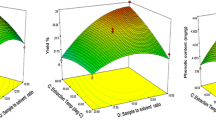Abstract
RSM was used to determine the optimum conditions for maximum recovery of phenolics from amla seed coat powder. At optimum conditions, TPC (total phenolic content) content and % DPPH free radical scavenging activity of extract were found to be 7.02 mg GAE / mL of extract and 42.69 %, respectively. Phenolics were extracted in water, diethyl ether, butanol and ethyl acetate. % DPPH free radical scavenging (61.07 %) activity was maximum in ethyl acetate fraction. The major phenolics in ethyl acetate extract were gallic, catechin, caffeic, quercetin, p-coumaric, vanillic and chlorogenic acids. Ethyl acetate extract was further fractionated with six fractions using methanol: water by column chromatography. Fraction V showed highest DPPH scavenging activity. The phenolics in different fractions of ethyl acetate extract were also estimated by GC-MS after derivatization. Caeffic, p-coumaric, hydroxy caeffic, vanillic, gallic and p-hydroxybenzoic acid were identified. Other components like tetracontane-1,40-diol and octadecanoic acid could also be identified.






Similar content being viewed by others
References
Angerosa FD, Alessandro N, Konstantinou P, Di Giacinto L (1995) GC-MS evaluation of phenolic compounds in virgin olive oil. J Agric Food Chem 43:1802–1807
Heo BG, Jang HG, Cho JY, Namiesnik J, Jastrzebski Z, Vearasilp K, Aguilar GG, Ayala ALM, Suhaj M, Gorenstein S (2013) Partial characterization of Indigo (Polygonum tinctorium Ait.) plant seeds and leaves. Indust Crops Prod 42:429–439
Ikawa M, Schaper TD, Dollard CA, Sasner JJ (2003) Utilization of Folin-Ciocalteau phenol reagent for the detection of certain nitrogen compounds. J Agric Food Chem 51(7):1811–1815
Li Y, Skouroumounis GK, Elsey MG, Taylor DK (2011) Microwave-assistance provides very rapid and efficient extraction of grape seed polyphenols. Food Chem 129:570–596
Liu X, Cui C, Zhao M, Wang J, Luo W, Yang B, Jiang Y (2008) Identification of phenolics in the fruit of emblica (Phyllanthus emblica L.) and their antioxidant activities. Food Chem 109:909–915
Liu X, Zhao M, Wu K, Chai K, Yu H, Tao Z, Wang J (2012) Immunomodulatory and anticancer activities of phenolics from emblica fruit (Phyllanthus emblica L.). Food Chem 131:685–690
Lu Y, Foo LY (2001) Antioxidant activity of polyphones from sage (Salvia officinalis). Food Chem 75:197–202
Luo W, Zhao M, Yang B, Shen G, Rao G (2009) Identification of bioactive compounds in Phyllanthus emblica L. fruit & their free radical scavenging activity. Food Chem 114:499–504
Luo W, Zhao M, Yang B, Ren J, Shen G, Rao G (2011) Antioxidant and antiproliferative capacities of phenolics purified from Phyllanthus emblica L. fruit. Food Chem 126:277–282
Mayachiew P, Devahastin S (2010) Effects of drying methods and conditions on release characteristics of edible chitosan films enriched with Indian gooseberry extract. Food Chem 118:594–601
Mishra P, Mahanta CL (2014) Comparative analysis of functional and nutritive values of amla (Emblica officinalis) fruit, seed and seed coat powder. Am J Food Technol 9(3):151–161
Morton JF (1996) The emblica (Phyllanthus emblica L.). Econ Botany 14:119–128
Nirmaladevi R, Padma PR, Kvitha D (2010) Analyses of the methanolic extracts of the leaves of Rhinacanthus nasutus. J Med Plants Res 4:1554–1560
Peschel W, Sanchez-Rabaneda F, Diekmann W, Plescher A, Garyzia I, Jimenez D (2006) An industrial approach in the search of natural antioxidants from vegetable and fruit wastes. Food Chem 97:137–150
Piljac-Zĕgarac J, Martinez S, Valek L, Stipcĕvić T, Kovacĕvić- Ganic K (2007) Correlation between the phenolic content and DPPH radical scavenging activity of selected Croatian wines. Acta Aliment 36:185–193
Poltanov EA, Shikov AN, Dorman HJD, Pozharitskaya ON, Makarov VG, Tikhonov VP (2009) Chemical and antioxidant evaluation of Indian gooseberry (Emblica officinalis Gaertn., syn. Phyllanthus emblica L.) supplements. J Phyto Res 23:1309–1315
Proestos C, Sereli D, Komaitis M (2006) Determination of phenolic compounds in aromatic plants by RP-HPLC and GC-MS. Food Chem 95:44–52
Rani P, Khullar N (2004) Antimicrobial evaluation of some medicinal plants for their anti-enteric potential against multi-drug resistant Salmonella typhi. J Phyto Res 18:670–673
Sabu MC, Kuttan R (2002) Anti-diabetic activity of medicinal plants and its relationship with their antioxidant property. J Ethanopharmacol 81:155–160
Seruga M, Navak I, Jakobek L (2011) Determination of polyphenolic content and antioxidant activity of some red wines by differential pulse voltametry; HPLC and spectrophotometric method. Food Chem 124:1208–1216
Sultana S, Ahmed S, Sharma S, Jahangir T (2004) Emblica officinalis reverses thioactamide induced oxidative stress and early promotional events of primary hepatocarcinogenesis. J Pharm Pharmacol 56:1573–1579
Vinson JA, Su X, Zubik L, Bose P (2002) Phenol antioxidant quantity and quality in foods: fruits. J Agric Food Chem 49(11):5315–5321
Zhang Q, Mang X, Sun X, Li B (2006) Stabilization of proanthocynadins from grape seeds. J Shenyang Agric Univ 37:232–234
Acknowledgments
Authors are thankful for the financial support received from University Grant Commission (UGC), India.
Author information
Authors and Affiliations
Corresponding author
Rights and permissions
About this article
Cite this article
Mishra, P., Dutta, N. & Mahanta, C.L. Partial extraction and identification of phenolics in Amla (Emblica officinalis) seed coat powder. J Food Sci Technol 52, 6990–7001 (2015). https://doi.org/10.1007/s13197-015-1835-y
Revised:
Accepted:
Published:
Issue Date:
DOI: https://doi.org/10.1007/s13197-015-1835-y




